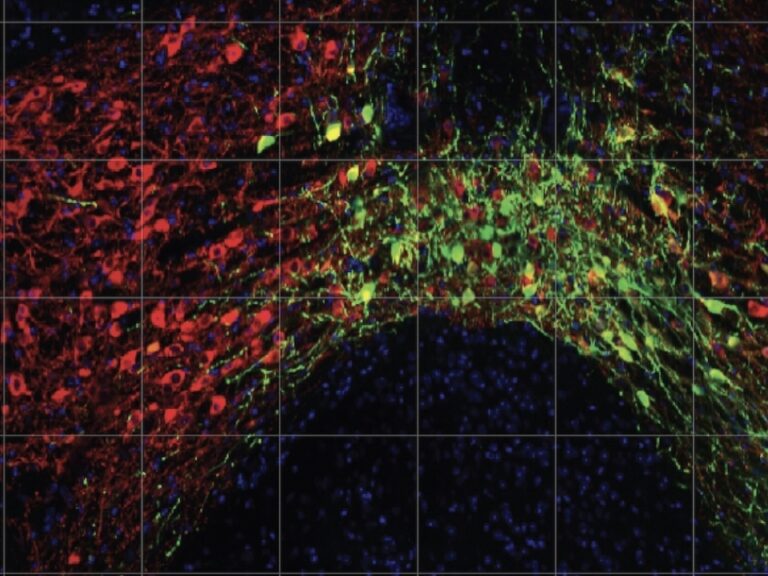A sensitive period in brain development during adolescence may set the stage for aggressive and impulsive behaviors in adulthood, if the results of a new mouse study conducted by Columbia University researchers also apply to people.
The study, published recently online in the journal Molecular Psychiatry, found that the brain in mid-adolescent mice is sensitive to dopamine, and exposure to too much dopamine during this time causes changes in the brain that lead to aggressive and impulsive behaviors during adulthood.
Identifying sensitive developmental periods that impact complex behaviors, such as impulsivity and aggression, is a new area in psychiatry research and should aid in understanding the origins of psychiatric disorders, as well as their diagnosis, prevention, and treatment.
Sensitive time periods in psychiatric illness
As organisms grow from embryo to adult, they pass through sensitive time-periods when developmental trajectories are influenced by environmental factors. While this form of developmental plasticity is usually beneficial to the organism, sometimes normal development can also be perturbed with negative consequences.
Sensitive time periods in the development of the vision and hearing are well studied, but the role of sensitive time periods in the development of psychiatric illnesses is mostly unknown.
The Columbia researchers took a close look at the brain’s dopamine system because it is implicated in several neuropsychiatric disorders, such as attention deficit disorder, depression, and schizophrenia.
Failing the mouse “marshmellow test”
To see if the development of the mouse brain is sensitive to dopamine at certain times, the researchers administered to mice a drug that increases dopamine levels in the brain. They then assessed impulsive behavior during adulthood with the mouse version of the “marshmellow test.”
The researchers found that mice exposed to extra dopamine in mid-adolescence, but not early or late adolescence, were more impulsive, and more likely to choose a small immediate reward than wait for a larger reward.
The mice exposed to extra dopamine in late adolescence were also more aggressive as adults, but showed no differences in cognition, motivation, and working memory.
Physiological changes in the brain drove these changes in behavior, the researchers also found. Mice that were exposed to excess dopamine in mid-adolescence had more active dopamine neurons in adulthood, and additional experiments confirmed that this biological change drove the aggressive and impulsive behaviors.
These insights may help improve the diagnosis, prevention, and treatment of attention deficit disorders, schizophrenia, bipolar disorder, and substance use disorders which frequently involve deficits in impulse control and increased aggression.
Implications for recreational drug use
Because stimulants, (including amphetamines, uppers, and ecstasy) raise dopamine levels, the findings also suggest that use of these drugs during mid-adolescence may highjack normal development with potentially harmful consequences.
Psychostimulants are also prescribed to children to treat attention deficit disorders, but the current study did not investigate the developmental effects of boosting dopamine in mice with dopamine deficits, as seen in ADHD.
“In a diseased state that results from dopamine deficits, transient exposure to psychostimulants during adolescence might potentially be corrective, but this hypothesis needs to be experimentally tested,” says Mark Ansorge, PhD, assistant professor of psychiatry at Columbia University Vagelos College of Physicians and Surgeons, who led the research.
“It is critical to understand the underlying biology to properly evaluate the risks and benefits of recreational or therapeutic drug exposure prior to adulthood.”
++++
Reference
“Dopamine transporter blockade during adolescence increases adult dopamine function, impulsivity, and aggression,” was published Aug. 4 in Molecular Psychiatry.
All authors (from Columbia and/or New York State Psychiatric Institute unless noted) are: Deepika Suri, Giulia Zanni, Darshini Mahadevia, Nao Chuhma, Rinki Saha, Stephen Spivack, Nicolò Pini, Gregory S. Stevens, Annette Ziolkowski-Blake, Eleanor H. Simpson, Peter Balsam, Stephen Rayport, and Mark S. Ansorge.
Deepika Suri, Giulia Zanni, and Darshini Mahadevia contributed equally.
This work was supported by the National Institute of Mental Health (grants R01MH099118 and R01MH068073), the National Institute on Drug Abuse (grant R01DA038966) and the Sackler Institute for Developmental Psychobiology.
The authors declare no competing interests.
Columbia University Media
Adult Aggression, Impulsivity May Have Roots in Mid-Adolescent Brain

